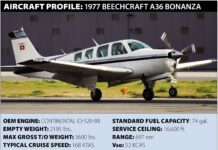by Ken Ibold
While many pilots fly only for recreation, the utility of airplanes is what drives the quest toward aircraft ownership and continued flying for most.
But it is also the utility that motivates pilots to make the kinds of errors that lead to tragedy. They push into circumstances that they or the airplane are ill-equipped to handle. When they escape unscathed, they have experience. But they do not always get away with a bad decision.
A pilot who lived in Wyoming used his Cessna 170 to commute to his job as a mechanic at an FBO in Denver – a distance of about 300 miles. In the 170, the trip took about three hours each way.
On a summers evening in May, the pilot departed the airport where he worked in Watkins, Colo., at about 7 p.m. for the flight home. There was bad weather in Wyoming, but it was moving quickly to the east and the pilot did not think it would affect the flight.
However, the pilot called his wife at about 10:30 and said he was on the ground in Casper, Wyo., because he had needed to divert around storms. He told his wife he would wait out the weather in Casper, about 90 miles from home. He called again at 12:30 a.m. to say the weather was still down and that he would probably sleep in the airplane and be home the next morning. He added, however, that he was going to visit the Flight Service Station on the field and see what they had to say.
At 4 a.m., Flight Service called the wife to ask if the pilot had arrived home. He had not closed his flight plan. The FSS worker said the pilot waited at the FSS office until 2:30 a.m., when the weather began to clear, and then decided to make the 50-minute flight home.
The pilots wife drove to the airport and did not find the airplane. A search was launched at about 6 a.m. and the airplanes wreckage was found at about 7:30. The pilot had made it about 15 miles from Casper before striking the ground in what searchers described as dense fog.
Although the pilot had 1,700 hours and a centerline-thrust multiengine rating, he did not have an instrument rating. He had amassed his flight time in little more than four years, and had flown more than 14 hours in the previous month.
The Casper weather about the time the pilot departed was marginal VFR. Although there was a scattered layer at 1,100 feet and an overcast at 2,000 feet, visibility under the clouds was 10 miles. The temperature/dewpoint spread was 4 degrees.
The airplane crashed in a field in an area of rolling terrain. The wreckage was strewn nearly 400 feet from the point of initial ground contact.
The pilots on-course heading would have been about 290 degrees, but the wreckage fanned out along a 168-degree heading. Whether that meant the pilot had decided to turn back and descended into terrain or that he lost control of the airplane and entered a spiral will forever be unknown. But the airplane apparently struck left-wing first and at a relatively high rate of speed.
Investigation revealed no evidence of a mechanical problem that would have cause the pilot to lose control, and the NTSB pinned the accident on the pilots continued flight into adverse weather and subsequent loss of control. However, there may be more to the story than that.
The fog reported by the search teams was present between 6 a.m. and the time the wreckage was found. But the airplane would have been there four hours earlier – possibly before the air cooled enough to create the fog.
Also consider that the pilot was alone, in the air, at 2:30 in the morning after working all day. Perhaps he took a nap at the Flight Service Station office or perhaps he had some coffee, but either would have been insufficient to keep him at his best.
That raises the possibility that he fell asleep. Without an autopilot, the airplane may have spiraled to its doom on its own.
In either case, the accident raises an interesting point about using airplanes for utility – and matching the airplanes capabilities and your own to the task at hand.
The desire to complete flights as planned is normal. The pilots attempt to get home after being gone a week is to be expected. But it is this kind of loss that makes the least sense, because it is so easily avoided – and so permanent.
Simply step back and look at how the chain is building – and what it will take to break the weakest link.
Also With This Article
“Aircraft Profile: Cessna 170”



